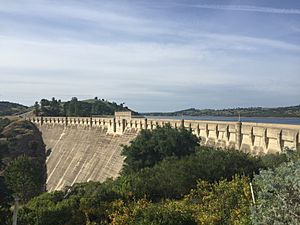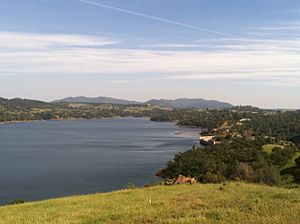Pardee Dam facts for kids
Quick facts for kids Pardee Dam |
|
|---|---|

View of the Pardee Dam from downstream.
|
|
| Location | Sierra Nevada Foothills Amador County, California Calaveras County, California |
| Coordinates | 38°15′27″N 120°51′01″W / 38.2574°N 120.8502°W |
| Opening date | 1929 |
| Operator(s) | East Bay Municipal Utility District |
| Dam and spillways | |
| Impounds | Mokelumne River |
| Height | 345 ft (105 m) |
| Length | 1,337 ft (408 m) |
| Reservoir | |
| Creates | Pardee Reservoir |
| Total capacity | 210,000 acre⋅ft (260,000,000 m3) |
| Catchment area | 575 sq mi (1,490 km2) |
| Surface area | 2,134 acres (864 ha) |
| Power station | |
| Installed capacity | 23.6 MW |
| Annual generation | 99,038,000 KWh (2001–2012) |
| Pardee Dam bridge | |
|---|---|
| Carries | Pardee Dam Road |
| Characteristics | |
| Width | 16 ft (4.9 m) |
Pardee Dam is a really tall structure, about 345 feet high. It was built across the Mokelumne River in California. This dam sits right on the border between Amador and Calaveras Counties. You can find it in the beautiful Sierra Nevada foothills, about 30 miles northeast of Stockton.
Contents
Building the Pardee Dam
Work on the Pardee Dam started in July 1927. It was finished pretty quickly, by 1929. The very first time water was sent through the Mokelumne Aqueduct from the dam was on June 23, 1929. A small town called Camp Pardee was built nearby. This camp was home to the people who worked to keep the dam running smoothly.
What Pardee Dam Does
The water held back by the dam forms Pardee Reservoir. This reservoir is the main source of water for the East Bay Municipal Utility District (EBMUD). EBMUD provides water to many homes and businesses in the San Francisco Bay Area. Most of the water in the reservoir comes from the snow that melts in the high Sierra Nevada mountains each year.
Reservoir Details
Pardee Reservoir usually covers about 3 square miles. It can hold a huge amount of water, about 215,000 acre-feet. The shoreline around the reservoir stretches for about 37 miles.
Rules for the Reservoir
There are special rules at Pardee Reservoir to keep the water clean and safe for drinking. California state law says that people cannot touch the water directly. This means you won't see water skiers, jet skis, or swimmers in Pardee Reservoir. However, boating and fishing are still very popular activities that people enjoy there.
Water's Journey
The water from Pardee Reservoir travels a long way across the Central Valley. It moves through a system of three large steel pipes called the Mokelumne Aqueduct. This aqueduct carries the water to other storage reservoirs located in the hills east of San Francisco Bay. From there, it becomes the drinking water for the East Bay region. The water is also used to create electric power, which is electricity made from moving water.
Who Was George Pardee?
Both the dam and the reservoir are named after George Pardee. He was an important politician from the Bay Area during a time called the "Progressive Era." This was a period when many people worked to solve social and political problems. George Pardee also served as the Governor of California.
Salmon and the River
Many dams have been built along the Mokelumne River. Because of these dams, Chinook salmon can no longer swim all the way up to where Pardee Reservoir is now. Their journey stops in the lower parts of the river.
Helping Salmon Thrive
In the fall of 2014, a lot of Chinook salmon returned to the river. It was the fifth largest count in 74 years, with over 12,118 salmon! Below the dam, there is a special hatchery. This hatchery is a joint project between EBMUD and the California Department of Fish and Wildlife. At the hatchery, about a fourth of the returning salmon are collected. Their eggs are used to help produce more baby salmon.
Scientists at the hatchery also work to control the river's water flow. They do this to encourage even more salmon to return to the river. When water levels are low, young fish might accidentally get pulled into water pumps that lead south past the delta. To prevent this, scientists use trucks to move the baby salmon from the hatchery to Sherman Island in the delta. The main goal of the hatchery is for these baby salmon to remember the Mokelumne River's water. This way, they will know to return to it when it's time for them to lay their own eggs.


